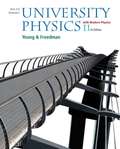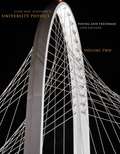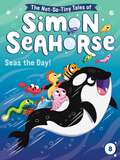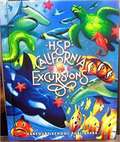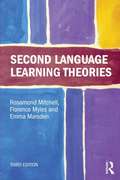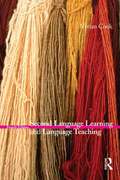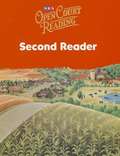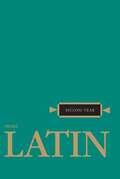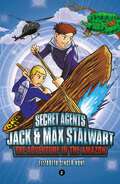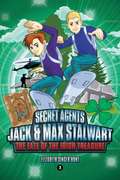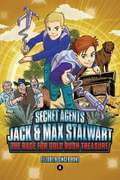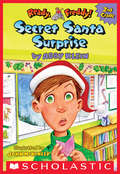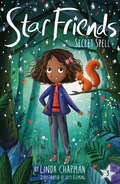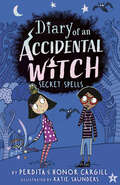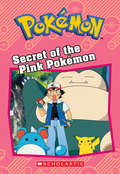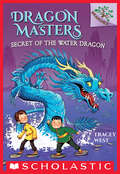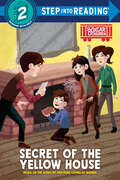- Table View
- List View
Searching for the Pygmy Hippo (Fountas & Pinnell Classroom, Guided Reading)
by Terry ShannonNIMAC-sourced textbook
Sears and Zemansky's University Physics: with Modern Physics, 11th Edition
by Roger A. Freedman A. Lewis Ford Hugh D. YoungThis book is the product of more than half a century of innovation in physics education. When the first edition of University Physics by Francis W. Sears and Mark W. Zemansky appeared in 1949, it was revolutionary among calculus-based physics textbooks in its emphasis on the fundamental principles of physics and how to apply them. The success of University Physics with generations of students and educators throughout the world is a testament to the merits of this approach. In preparing this new Eleventh Edition, we have further enhanced and developed University Physics to emphasize two key objectives: helping students develop conceptual understanding, and helping them build strong problem- solving skills.
Sears and Zemansky's: University Physics, Volume 2
by Roger A. Freedman A. Lewis Ford Hugh D. YoungUniversity Physics Volume 2 (Chapers 21-37), 13/e continues to set the benchmark for clarity and rigor combined with effective teaching and research-based innovation. University Physics is known for its uniquely broad, deep, and thoughtful set of worked examples-key tools for developing both physical understanding and problem-solving skills. The Thirteenth Edition revises all the Examples and Problem-Solving Strategies to be more concise and direct while maintaining the Twelfth Edition's consistent, structured approach and strong focus on modeling as well as math. To help students tackle challenging as well as routine problems, the Thirteenth Edition adds Bridging Problems to each chapter, which pose a difficult, multiconcept problem and provide a skeleton solution guide in the form of questions and hints. The text's rich problem sets-developed and refined over six decades-are upgraded to include larger numbers of problems that are biomedically oriented or require calculus. The problem-set revision is driven by detailed student-performance data gathered nationally through MasteringPhysics®, making it possible to fine-tune the reliability, effectiveness, and difficulty of individual problems.
Seas the Day! (The Not-So-Tiny Tales of Simon Seahorse #8)
by Cora ReefSimon gives his friend a proper send-off before she moves away in this eighth book in The Not-So-Tiny Tales of Simon Seahorse chapter book series.Simon&’s friend DeeDee is moving away! He&’s really going to miss her and decides to show her the best last day ever before she leaves Coral Grove. He comes up with lots of fun activities like bubble jumping, and he even arranges a special concert. But when the big day arrives, things don&’t go as planned. What if DeeDee&’s last day turns out to be a total disaster? With easy-to-read language and illustrations on almost every page, The Not-So-Tiny Tales of Simon Seahorse chapter books are perfect for emerging readers.
Seashell Detective (Fountas & Pinnell Classroom, Guided Reading)
by Alice McGintyNIMAC-sourced textbook. THE SECRETS OF SEASHELLS. Did you ever pick up a seashell and wonder about the creature that once lived inside? How could you find out the answer? In this book, you will learn how to become a seashell detective.
Second Fiddle (Fountas & Pinnell Classroom, Guided Reading Grade 5)
by Ronan McCarthy Simon DupuisA SECOND-CLASS HERO? Arnold is a member of The Squad of Goodness, but his teammates generally have him stay out of the way until the action's over and done with. Does that make him any less of a superhero? NIMAC-sourced textbook
Second Grade Studies Weekly, [Grade] 2 Social Studies
by Inc. American Legacy PublishingNIMAC-sourced textbook
Second Language Learning Theories
by Rosamond Mitchell Florence Myles Emma MarsdenSecond Language Learning Theories provides a clear and concise overview of the field of second language acquisition (SLA) theories. Written by a team of leading academics working in different SLA specialisms, this book provides expert analysis of the main theories from multiple perspectives to offer a broad and balanced introduction to the topic. The book covers all the main theoretical perspectives currently active in the SLA field and sets them in a broader perspective per chapter, e. g. linguistic, cognitive or sociolinguistic. Each chapter examines how the various theories view language, the learner and the acquisition process. Summaries of key studies and examples of data relating to a variety of languages illustrate the different theoretical perspectives. Each chapter concludes with an evaluative summary of the theories discussed. This third edition has been thoroughly updated to reflect the very latest research in the field of SLA. Key features include: * A fully re-worked chapter on cognitive models of language * A new chapter on information processing, including language production and comprehension * The addition of a glossary of key linguistic terms to help the non-specialist * A new timeline of second language learning theory development. This third edition takes account of the significant developments that have taken place in the field in recent years. Highly active domains in which theoretical and methodological advances have been made are treated in more depth to ensure that this new edition of Second Language Learning Theoriesremains as fresh and relevant as ever.
Second Language Learning and Language Teaching
by Vivian CookThe fourth edition of this classic textbook has been revised to reflect recent developments in language teaching and learning yet retains the basic structure and approach so popular with its readers. Teaching and learning content has been updated, particularly taking into account the rise of task-based learning, Conversational Analysis and social models of second language acquisition, changes in national syllabuses and examinations and the increasing controversy over the role of the native speaker target. Each chapter has been revised to stand alone, enabling the text to be taught and studied out of sequence if preferred. A set of focusing questions has also been added to each and further reading sections have been updated. Second Language Learning and Language Teaching remains the essential textbook for all student teachers of modern languages and TESOL as well as applied linguistics.
Second Language Part -2 Telugu Paper-II School Of Distance Education, Andhra University Telugu BA BCom BSc Common Core Second Year
by Dr Sheikh Imamkhasim Dr R Ram Satynanarayana Dr R Sri Venkateswara Rao Dr P Srinivasa Rao G Sambasiva Rao B Prasad Rao K Seeta Rama Chandra Murthy M Subba Rao Dv Surya Rao+-
Second Reader (Open Court Reading)
by Sra Mcgraw-HillSRA's Open Court Reading Second Reader contains The Plane Trip; The Special Day; The Library Trip; Our Class Trip; and The Camera Kid.
Second Year Latin
by Robert J. HenleThe backbone of Henle Latin Second Year is intensive language study, including review of the first year plus new materials. Separated into four parts, Henle Latin Second Year includes readings from Caesar's Commentaries, extensive exercises, and Latin-English vocabularies. Humanistic insight and linguistic training are the goals of the Henle Latin Series from Loyola Press, an integrated four-year Latin course. Time-tested and teacher endorsed, this comprehensive program is designed to lead the student systematcially through the fundamentals of the language itself and on to an appreciation of selected classic texts.
Secondhand Superstars (Into Reading, Level S #41)
by Heather Hammonds Diane FeyerNIMAC-sourced textbook. One day at school, Sasha is teased for wearing secondhand clothes. Sasha's brother, Chris, comes up with an idea to cheer her up and show everyone how wearing recycled clothing can benefit people and the planet. Sasha's best friend, Kaz, is excited about helping out, too. With the assistance of a mystery guest, their plan might just work!
Secret Agents Jack and Max Stalwart: Brazil (The Secret Agents Jack and Max Stalwart Series #2)
by Elizabeth Singer HuntFor fans of the award-winning SECRET AGENT JACK STALWART series comes a must-read new chapter book series! Now Jack teams up with his older brother, Max, to solve new international mysteries, using their special training as secret agents. Secret agents Jack and Max Stalwart are sent to the Amazon jungle to investigate the disappearance of an important Global Protection Force scientist. Soon, they discover that the scientist's disappearance is no accident. A greedy outlaw is illegally mining for gold and he'll stop and nothing to keep his secret safe. Can Jack and Max save themselves and the scientist from almost certain death?
Secret Agents Jack and Max Stalwart: The Fate of the Irish Treasure: Ireland (Secret Agents Jack and Max Stalwart Series #3)
by Elizabeth Singer Hunt Brian WilliamsonThe third jet-setting installment in the thrilling award-winning chapter book series Secret Agents Jack and Max Stalwart, by Elizabeth Singer Hunt (Secret Agent Jack Stalwart). <P><P>Now Jack teams up with his older brother Max to solve an intriguing Irish mystery, using their special training as secret agents. Ireland's greatest national treasure, the sacred Book of Kells, vanishes from a library in Dublin. Clues point to the Mastermind being involved. Will Jack and Max be able to find the Book and uncover the Mastermind's identity before he strikes again?
Secret Agents Jack and Max Stalwart: The Race for Gold Rush Treasure: California, USA (Book 4) (Secret Agents Jack and Max Stalwart #4)
by Elizabeth Singer Hunt Brian WilliamsonThe fourth globe-trotting installment in the exciting Secret Agents Jack and Max Stalwart series, by beloved children's author Elizabeth Singer Hunt (author of the award-winning Secret Agent Jack Stalwart series). Now Jack teams up with his older brother Max to solve a thrilling California puzzle, using their special training as Global Protection Force agents.In the foothills of California's Sierra Nevada Mountains, an unbelievable discovery is made: $10 million in rare coins dating back to the California Gold Rush! Secret Agents Jack and Max Stalwart are sent to protect the treasure. But almost as soon as they arrive, it vanishes into thin air. Little do they know that the culprit is someone from Jack's past. Unfortunately for the brothers, the criminal isn't only after the loot. He wants revenge.
Secret Santa Surprise! (Ready, Freddy! 2nd Grade #3)
by Abby Klein John MckinleyFreddy is ready -- for 2nd Grade! It's almost Christmas, and Freddy is thrilled when his teacher tells the class that they'll be doing a Secret Santa gift swap. He can't wait to make a special present for one of his friends -- until Freddy picks the worst name in the class! Freddy can't believe it, but maybe with some help from his friends he can be the best Secret Santa ever!
Secret Spell (Star Friends)
by Linda ChapmanDo you believe in magic? Lexi and her friends do! And when they meet the Star Animals, a whole world of magical adventures unfolds in this new chapter book from the Star Friends series featuring black and white illustrations throughout.Lexi and her star animal, a squirrel named Juniper, must use their special powers to stop the forces of dark magic. The Star Friends fear that more dark magic is brewing. And now the friends themselves are arguing! Will their Star Animals be able to convince them to work together again?In the Star Friends chapter book series, Mia and her friends Lexi, Sita, and Violet all discover that they are Star Friends -- they can communicate with the animals that have traveled from the Star World. The animals show the girls how to use their unique magic abilities to do good. A whole world of magical adventures awaits!
Secret Spells (Diary of an Accidental Witch)
by Honor Cargill Perdita CargillEveryone at the Extraordinary School is excited for the Winter Solstice Grand Tournament—especially Bea! But this year's tournament will be different: Extraordinary will compete against Spellshire Academy, and there's no magic allowed! Who will emerge victorious? And will Bea's friendship with her best non-witchy friend, Ash, survive the competition?Everyone at the Extraordinary Academy is excited for the Winter Solstice Grand Tournament, especially Bea! She&’s been practicing extra-hard and is ready to rise to the challenge. But then Ms. Sparks decides that this year&’s competition will be different—there won&’t be any magic allowed! It will be a regular sports day, and the students at Extraordinary will compete against non-magic school Spellshire Academy. With magic firmly forbidden, which school will emerge victorious? And will Bea&’s friendship with her non-witch best friend, Ash, survive the competition? With black-and-white illustrations throughout. Told through Bea's diary entries, the Diary of an Accidental Witch series invites readers to follow Bea on a humorous journey of self-discovery as she learns where she truly belongs.
Secret of the Pink Pokémon (Pokémon Chapter Books)
by Tracey WestThis reissued illustrated chapter book is based on the classic characters found in Pokemon GO and the classic animated series on Netflix.The Orange Islands are weird! Ash and the gang discover Pokémon they've never seen before. Onix is made of crystal. Rhyhorn has turned pink. Marill has super sonar. And Snorlax is on a feeding frenzy! There is one thing Ash can count on. Team Rocket is setting their usual traps to swipe rare Pokémon—and Pikachu, of course. Can Ash stop them before Pikachu becomes Pink-achu? This reissued illustrated chapter book is based on the classic characters found in Pokemon GO and the classic animated series on Netflix.
Secret of the Water Dragon: A Branches Book (Dragon Masters #Bk.3)
by Tracey WestDrake and the rest of the Dragon Masters are back for another adventure!This series is part of Scholastic's early chapter book line called Branches, which is aimed at newly independent readers. With easy-to-read text, high-interest content, fast-paced plots, and illustrations on every page, these books will boost reading confidence and stamina. Branches books help readers grow! In this third book in the series, someone is trying to steal the Dragon Stone. Drake soon discovers that the thief is his friend and fellow Dragon Master, Bo! Could the dark wizard somehow be behind this? The Dragon Masters must find a way to protect the Dragon Stone--and keep Bo's family out of danger. Will the secret to solving their problems lie with Bo's dragon, Shu? Drake is about to find out!
Secret of the Yellow House: Boxcar Children Early Reader (Step into Reading) (Step into Reading)
by Gertrude Chandler WarnerThe Alden children were searching for a home–and found a life of adventure! Embark on an exciting journey with the Boxcar Children in this Step 2 leveled reader, as they investigate a mysterious house on their family&’s private island. Perfect for early readers learning to read simple sentences. Many years ago, a man disappeared from the yellow house on Surprise Island. With a bit of sleuthing, the Aldens find a clue to the mystery! Can they uncover the truth of what happened so long ago? Adapted from Gertrude Chandler Warner's The Yellow House Mystery chapter book, this early reader allows children to start reading with a Boxcar Children classic.Step 2 Readers use basic vocabulary and short sentences to tell simple stories. For children who recognize familiar words and can sound out new words with help.

